Second successful sterilisation campaign.
The AWARE Trust team recently returned from Machuchuta Communal Land in the Greater Mapungubwe (formerly Limpopo-Shashe) Trans Frontier Conservation Area (GMTFCA) where it successfully completed the second of its dog sterilisation, vaccination and health care clinics. Machuchuta, which is 140km west of Beitbridge, is adjacent to Maramani Communal Land where the first spay campaign was run. AWARE had many requests to return to this area as several dogs missed out on the first spay campaign because they lived more than 20km away. Machuchuta is 24km east of the Tuli Circle, and is more remote and less populated than Shashe in Maramani.
The AWARE team consisted of:
- Dr Keith Dutlow
- Dr Lisa Marabini
- Dr Vinay Ramlaul
- Chris Scott
- Ed Oelofse
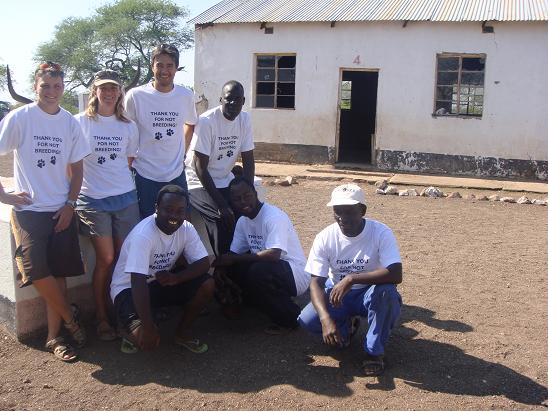
- Elliot Katanda
- Kenny Chitukudza.
AWARE worked in partnership with Department of Veterinary Services staff, namely:
- Beitbridge District Veterinary Officer, Dr Columbus Chaitezvi
- Animal Health Inspector Samson Ndlovu
- Diptank attendant Denmore Ncube
- Animal science student Rugare Mnakiri
We arrived in Machuchuta at about 5pm on Sunday the 1st November, after a ten hour haul in 4 vehicles from Harare. Dr Chaitezvi, who was not yet present, had arranged for us to camp at the District Development Fund (DDF) compound, as there is no government animal health centre in Machuchuta. The DDF attendant was reluctant to let us in at first because the arrangement was for us to set up in the ‘pull in camp’ next door which had no facilities except for a long drop toilet. After some persuasion we were allowed to enter the fenced DDF premises, into which we were locked for the evening. The facilities consisted of 3 locked buildings, a kitchen area, a long drop and an open air garage, with no electricity or water. We wearily set up tents in the dark amidst several scorpions that were on the prowl, and then collapsed into bed tired and dirty.
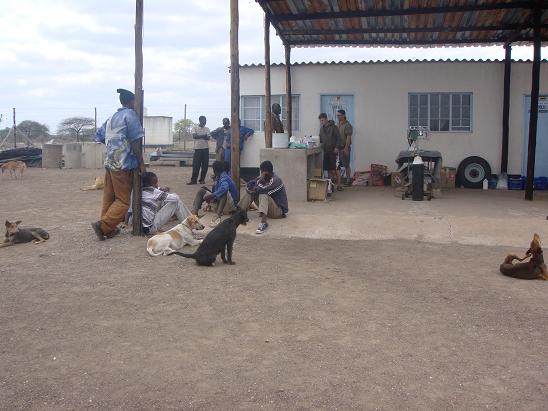 The following morning it became evident that Dr Chaitezvi had been detained, so we had to again use our powers of persuasion to set up an operating table under the roof of the open-air garage that also housed a tractor. We promised the DDF attendant that Dr Chaitezvi would sort out any problems that might arise from us starting operations. Ed and Kenny were dispatched to get water in a 200l drum from a nearby manual borehole. Soon after breakfast the first patients arrived which showed the effective advertising done by the Department with posters supplied by AWARE. The following morning it became evident that Dr Chaitezvi had been detained, so we had to again use our powers of persuasion to set up an operating table under the roof of the open-air garage that also housed a tractor. We promised the DDF attendant that Dr Chaitezvi would sort out any problems that might arise from us starting operations. Ed and Kenny were dispatched to get water in a 200l drum from a nearby manual borehole. Soon after breakfast the first patients arrived which showed the effective advertising done by the Department with posters supplied by AWARE.
 The team quickly set to work on the scrawny pups in our best turn-out to date, with 14 ops and 44 vaccinations performed on the first day. Dogs were sterilised on the ‘surgery’ table and they recovered on blankets a few meters away. It was an advantage that most members of the team had worked together before, and newcomers Ed and Chris quickly proved their usefulness by assisting the vets wherever they could. All animals were vaccinated with Merial’s DA2PPi2LR vaccine which combines the traditional 7 in 1 (including distemper) with rabies in one easy injection. We are grateful to Medi-Vet, importers of this convenient product, who supplied the vaccine. Very young pups were vaccinated for parvo only. All dogs also received much needed de-wormer (fenbendazole), and Frontline for ticks and fleas, courtesy of Medi-Vet. The dogs that were sterilised went home with 1kg of Fetch dog kibbles, courtesy of Medi-Vet, to help them through their convalescence. The team quickly set to work on the scrawny pups in our best turn-out to date, with 14 ops and 44 vaccinations performed on the first day. Dogs were sterilised on the ‘surgery’ table and they recovered on blankets a few meters away. It was an advantage that most members of the team had worked together before, and newcomers Ed and Chris quickly proved their usefulness by assisting the vets wherever they could. All animals were vaccinated with Merial’s DA2PPi2LR vaccine which combines the traditional 7 in 1 (including distemper) with rabies in one easy injection. We are grateful to Medi-Vet, importers of this convenient product, who supplied the vaccine. Very young pups were vaccinated for parvo only. All dogs also received much needed de-wormer (fenbendazole), and Frontline for ticks and fleas, courtesy of Medi-Vet. The dogs that were sterilised went home with 1kg of Fetch dog kibbles, courtesy of Medi-Vet, to help them through their convalescence.
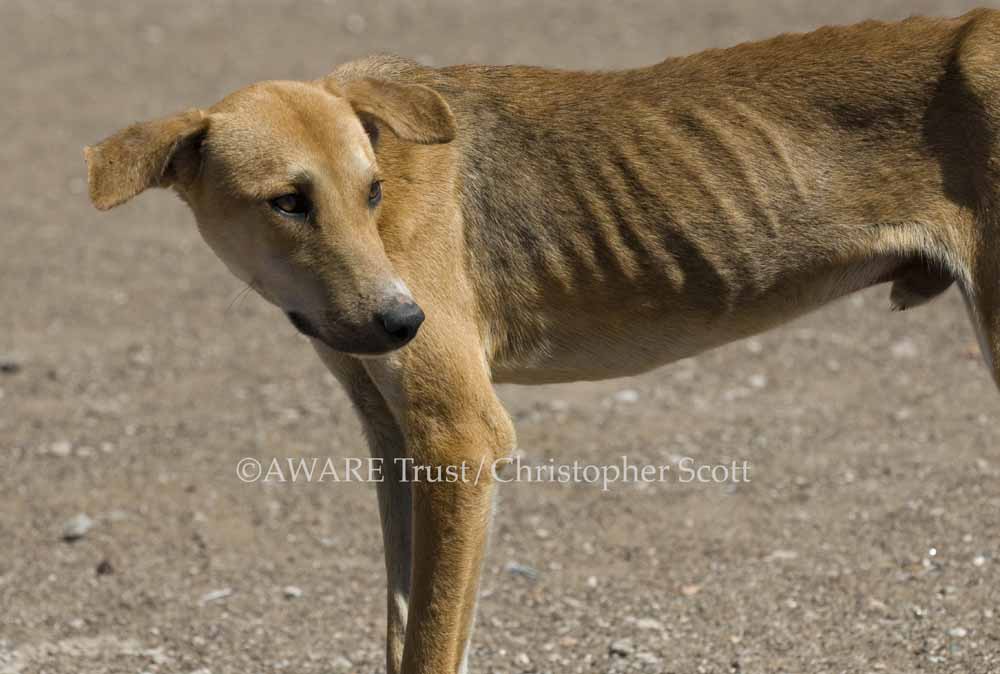 Blood samples were taken from each dog that was sterilised in order to determine its haematocrit (percentage of red blood cells in the blood), and to study what pathogens the dogs have been exposed to. A normal haematocrit for dogs is considered to be between 30 and 50%, below which a dog is considered to be anaemic. We were horrified at some of the haematocrit readings, which were as low as 14%, with an average of 23% and only 20/55 dogs having a haematocrit above 25%. Operating on dogs in such poor condition means that extra care has to be taken with all anaesthetic and surgical procedures, and should only be attempted by competent, experienced veterinarians. We are extremely pleased that we had another 100% survival rate on this campaign. Blood samples were taken from each dog that was sterilised in order to determine its haematocrit (percentage of red blood cells in the blood), and to study what pathogens the dogs have been exposed to. A normal haematocrit for dogs is considered to be between 30 and 50%, below which a dog is considered to be anaemic. We were horrified at some of the haematocrit readings, which were as low as 14%, with an average of 23% and only 20/55 dogs having a haematocrit above 25%. Operating on dogs in such poor condition means that extra care has to be taken with all anaesthetic and surgical procedures, and should only be attempted by competent, experienced veterinarians. We are extremely pleased that we had another 100% survival rate on this campaign.
 The extreme state of nutritional stress in these animals arises mainly from being left to scavenge, lactation in females, internal and external parasites (worms, ticks and fleas), and possibly other diseases. Transmissable venereal tumour (TVT) which is a sexually transmitted form of cancer, was particularly prevalent in the dogs in Machuchuta. Transmission can be prevented by neutering animals. I have always wondered why these starving dogs don’t chase and eat the chickens that freely roam around the homesteads. It became evident when one of the emaciated dogs refused to eat an egg that I offered it – I was told that the villagers train their dogs not to eat eggs by feeding them an egg and them beating them so that they never do it again! In an environment where food is a luxury, animals always come off second best. The extreme state of nutritional stress in these animals arises mainly from being left to scavenge, lactation in females, internal and external parasites (worms, ticks and fleas), and possibly other diseases. Transmissable venereal tumour (TVT) which is a sexually transmitted form of cancer, was particularly prevalent in the dogs in Machuchuta. Transmission can be prevented by neutering animals. I have always wondered why these starving dogs don’t chase and eat the chickens that freely roam around the homesteads. It became evident when one of the emaciated dogs refused to eat an egg that I offered it – I was told that the villagers train their dogs not to eat eggs by feeding them an egg and them beating them so that they never do it again! In an environment where food is a luxury, animals always come off second best.  This point was also brought home to me whilst watching one of the spays recovering. A huge tube of the most foul-smelling vomit I have ever witnessed snaked its way out of the dog’s mouth potentially compromising her breathing. As I reached into the back of her mouth to clear her airways I realised that what she was bringing up was a carcass that must have been infested with maggots for at least 3 days before she had consumed it - by the time it came back up it truly smelled like it emanated from the bowels of hell. I had extreme difficulty suppressing a gag reflex. This point was also brought home to me whilst watching one of the spays recovering. A huge tube of the most foul-smelling vomit I have ever witnessed snaked its way out of the dog’s mouth potentially compromising her breathing. As I reached into the back of her mouth to clear her airways I realised that what she was bringing up was a carcass that must have been infested with maggots for at least 3 days before she had consumed it - by the time it came back up it truly smelled like it emanated from the bowels of hell. I had extreme difficulty suppressing a gag reflex.
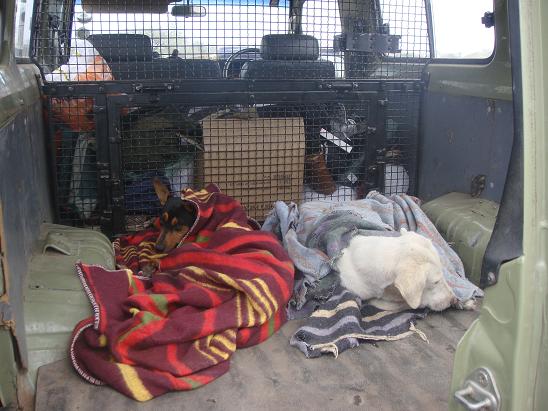 On our second night our tents were battered around by an extremely strong wind that came up with the full moon and the temperature had dropped considerably by the next morning. A temperature check of our first bitch spay five minutes after the op revealed she had gone into a state of hypothermia, with her temperature at 33.6 degrees Celsius. Everybody jumped into action and she was quickly surrounded by makeshift hot water bottles (latex gloves filled with hot water), and soon had warm intravenous fluids pumping into her. It took the better part of two nerve-racking hours for her temperature to inch up to 36.0, at which point she started to come round. Due to the delay only 7 ops were done that day. On our second night our tents were battered around by an extremely strong wind that came up with the full moon and the temperature had dropped considerably by the next morning. A temperature check of our first bitch spay five minutes after the op revealed she had gone into a state of hypothermia, with her temperature at 33.6 degrees Celsius. Everybody jumped into action and she was quickly surrounded by makeshift hot water bottles (latex gloves filled with hot water), and soon had warm intravenous fluids pumping into her. It took the better part of two nerve-racking hours for her temperature to inch up to 36.0, at which point she started to come round. Due to the delay only 7 ops were done that day.
Dr Chaitezvi arrived on the second day and negotiated for us to use two empty DDF rooms – one for operating – which substantially reduced the wind chill and potential dust factor for the dogs on the operating table, and one for dogs to recover in - which meant that recovering dogs could be detained (several of the patients self-released by digging under the DDF perimeter fence almost as soon as they could stagger around). The resilience of these dogs is quite astounding – imagine expecting a city pet to find its own way home (often 6-10km away) after major surgery! – but somehow they all do. The lucky ones got carried home, and some dogs went home in a donkey-drawn scotch cart. The owners were told to return with their dogs in 72 hours for a check-up, at which point the dogs were de-wormed, and the owners were given a T-shirt for participating in the programme.
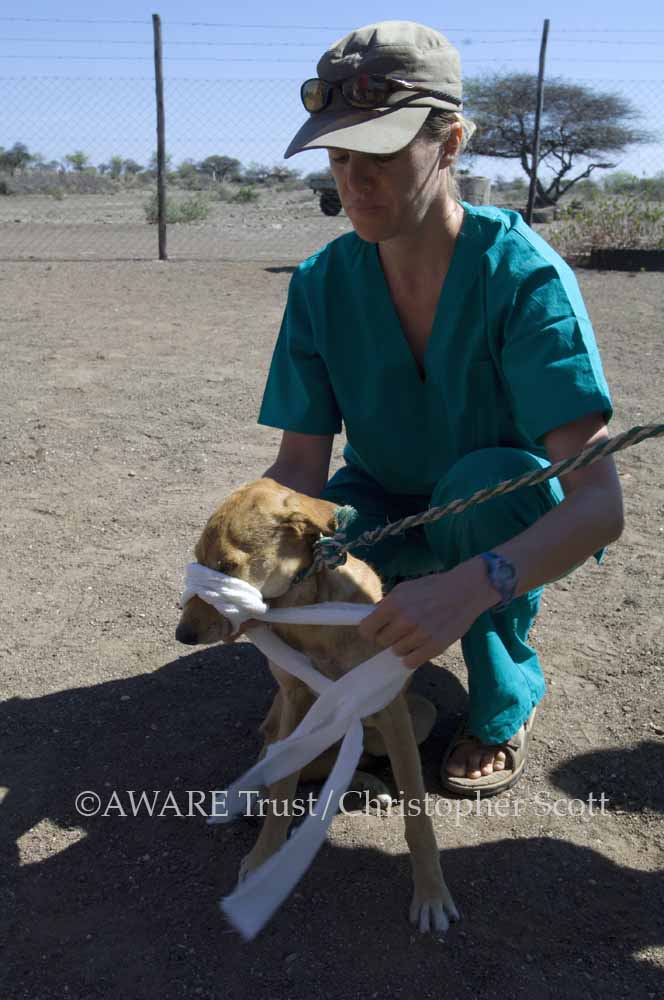 The following mornings also proved to be busy and chaotic. By day two, Ed had had enough of villagers trying to handle dogs by gripping them round their throats and lifting them off the ground, and with Samson translating, she instituted a 15 minute training session of how to hold and restrain a dog. Some villagers made an effort, but there are always a few dogs that need to be pole-syringed because they are totally unapproachable. One of these dogs belonging to an older woman actually chased Ed down aggressively, so we decided to try it with a sedative in a piece of meat. The tablet was duly placed in some chicken breast, which the dog looked at with disdain. Interestingly, the old woman had trained her dog not to eat raw meat as so many villagers set poisoned bait in raw meat for hyaenas. Once we had flame-grilled the chicken, the dog wolfed the tablet down and became groggy enough to be pole-syringed. The following mornings also proved to be busy and chaotic. By day two, Ed had had enough of villagers trying to handle dogs by gripping them round their throats and lifting them off the ground, and with Samson translating, she instituted a 15 minute training session of how to hold and restrain a dog. Some villagers made an effort, but there are always a few dogs that need to be pole-syringed because they are totally unapproachable. One of these dogs belonging to an older woman actually chased Ed down aggressively, so we decided to try it with a sedative in a piece of meat. The tablet was duly placed in some chicken breast, which the dog looked at with disdain. Interestingly, the old woman had trained her dog not to eat raw meat as so many villagers set poisoned bait in raw meat for hyaenas. Once we had flame-grilled the chicken, the dog wolfed the tablet down and became groggy enough to be pole-syringed.
We were very pleased with the 72 hour checks this time round and there were no post-op complications related to infections. We attribute this largely to having enough sterile gloves and spay kits (thank you, John and Leonie Cullen) to use only autoclaved instruments on each bitch spay. Only 2 dogs failed to be presented for their check-ups because they could not be handled by their owners. The owners of these animals did check in however and reported that their dogs were happy and eating.
The owner of one of the castrates that we had checked on day 3 returned on day 4 and said his dog could not walk. We paid this dog a homestead visit to find the dog salivating profusely, with partial paralysis of the hindlimbs, and the dog was screaming in agony every time it tried to move. We immediately suspected rabies, but were fortunate enough to have Dr Chaitezvi, with local knowledge, with us and he thought that a likely differential diagnosis was a sting from a fat-tailed scorpion. We elected to treat the animal (with a pole syringe) and when we checked it the following day it was 70% improved – able to walk and not salivating but still incredibly sore. The Bristows, who live in the area, reported their dog being stung at almost exactly the same time!
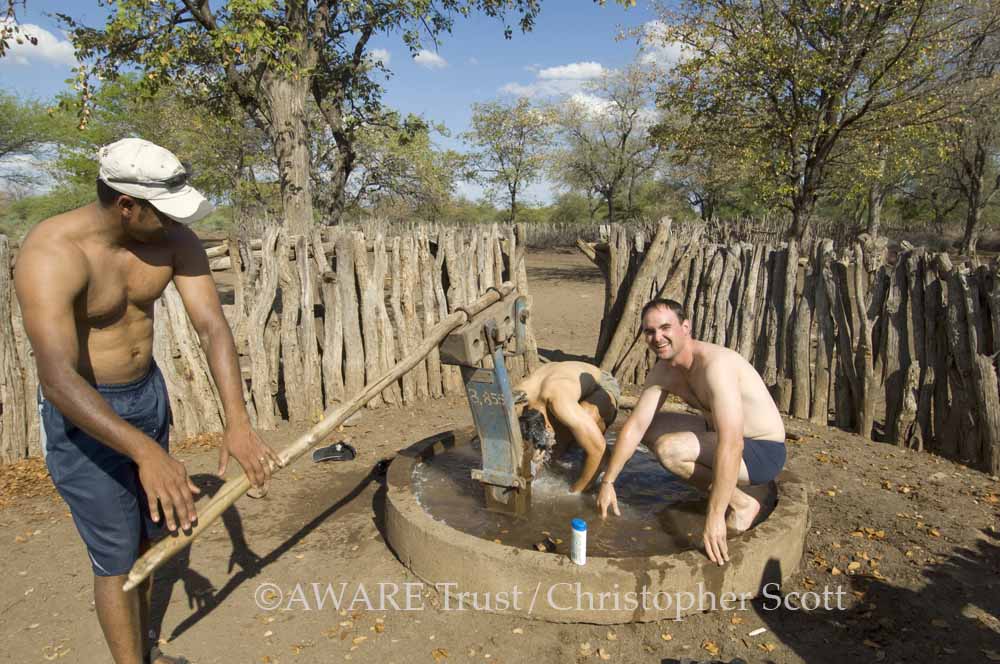 Operations would generally finish by lunchtime. After a bite to eat, blood samples would be processed then in the late afternoon we would take a trip to the manual borehole to collect water and shower. The cold wind did not last long, and we were soon struggling to move in temperatures of 40 degrees Celsius in the shade. Operations would generally finish by lunchtime. After a bite to eat, blood samples would be processed then in the late afternoon we would take a trip to the manual borehole to collect water and shower. The cold wind did not last long, and we were soon struggling to move in temperatures of 40 degrees Celsius in the shade.
A couple of emaciated donkeys were also treated for internal and external parasites and their owners were given pamphlets on ‘Draught animals in Zimbabwe’ which details correct care of working animals.
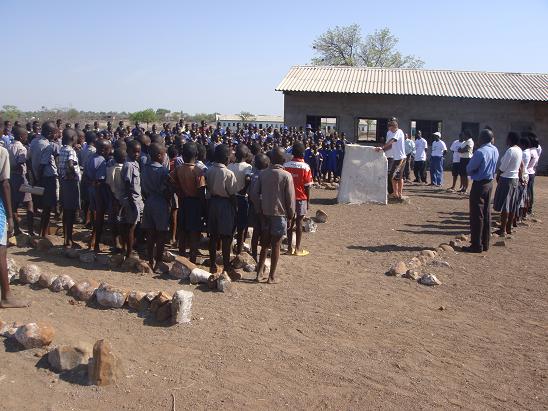 Five days into the campaign we made contact with the local primary school and delivered them a box of donated crayons and neo-magics, as well as a hundred photocopied posters of animals. The school accommodates around 400 pupils so the kids were asked to get into groups of 4 and colour in the posters as a competition. The top two posters (8 kids) were awarded T-shirts as a prize when we returned a few days later, and Ed and Samson once again delivered a lecture on animal handling, welfare and the importance of having your dogs vaccinated and neutered. This was received very well by the school. Five days into the campaign we made contact with the local primary school and delivered them a box of donated crayons and neo-magics, as well as a hundred photocopied posters of animals. The school accommodates around 400 pupils so the kids were asked to get into groups of 4 and colour in the posters as a competition. The top two posters (8 kids) were awarded T-shirts as a prize when we returned a few days later, and Ed and Samson once again delivered a lecture on animal handling, welfare and the importance of having your dogs vaccinated and neutered. This was received very well by the school.
Vin and Elliot left on Sunday morning, and the rest of the team stayed till Monday to complete the check-ups. We ended up having to turn away about 15 operations on our last day. We suspect that because we were more remote and not in a village ‘centre’ like Shashe, the news of our operations had travelled more slowly resulting in the late arrivals. AWARE also donated 100 doses of rabies vaccinations to the Government for further rabies vaccination in the area.
Between the 1st and 9th of November, AWARE spayed 33 bitches and castrated 22 male dogs making a total of 55 sterilisations. 254 dogs were vaccinated, Frontlined and de-wormed and several more were treated for veterinary conditions.
The table below shows the number of dogs that were operated on:
|
Day:
|
Mon.
|
Tues.
|
Wed.
|
Thurs.
|
Fri.
|
Sat.
|
Total
|
|
Spayed
|
8
|
5
|
6
|
4
|
5
|
5
|
33
|
|
Neutered
|
6
|
2
|
7
|
3
|
2
|
2
|
22
|
|
Total
|
14
|
7
|
13
|
7
|
7
|
7
|
55
|
This year AWARE has sterilised 145 dogs and vaccinated 419 in the Greater Mapungubwe TFCA. We believe this has prevented approximately 450 puppies being born this year, and stopped the potential transmission of fatal diseases into wild carnivore populations. There has been a recent outbreak of distemper which has caused fatalities in a number of lions in the Kgalagadi TFCA in Botswana. The outbreak is thought to emanate from dogs in the surrounding areas. Thus we feel our sterilisation and vaccination programme has enormous conservation value, as well as improving the welfare of village dogs, and raising awareness of animal welfare at grass roots level.
The AWARE team is sincerely indebted to the following people who made this campaign possible:
- NSPCA Blue Cross, and in particular Christine Shields. Blue Cross funds paid for the anaesthetic drugs, long acting antibiotics, surgical gloves, catgut, Scrub-up and methylated spirits. Christine also organised the crayons and photocopied posters for the kids.
- The 24 Hour Veterinary Surgery (Dr Vinay Ramlaul) who loaned us an anaesthetic machine, 2 surgical kits and several other surgical bits and pieces and paid for his own fuel to get there. Not to mention that he worked flat out in extremely trying circumstances. We are extremely happy he is now part of the permanent AWARE team.
- Chris, Ed, Elliot and Kenny for their dedicated hard work and commitment to performing the best possible work under difficult circumstances.
- All the Veterinary Department personnel who were enthusiastic and a pleasure to work with, and without whom we would not have had such good co-operation from the villagers.
- Medi-Vet P/L (Zimbabwe) who sponsored all the vaccinations, the de-wormer, 120 kg of Fetch dog kibbles, the T-shirts, and the Frontline.
- Nadia Marabini for another cash donation of US$1000.
- John and Leonie Cullen for the spay kits, and Meryl Harrison for facilitating this.
- The Wildlife Veterinary Unit for the loan of a vehicle, microscope, camping and blood processing equipment.
- Meuller Investments (Hasnain Mohammed) for a donation of cotton wool.
- Cactus Advertising, Design and Print (Sue Burr) who organised the advertising posters.
- Vetpharm (Russell Hendrix) for a donation of scalpel blades.
- Coopers (Ev Cock) for donating ‘Draught Animals in Zimbabwe’ pamphlets.
- Chisipite Veterinary Surgery for the loan of a surgical pack.
- All individuals who contributed through the Debby Hart exhibition or the 24 hour surgery.
If you would like to support our next campaign please contact lisa@awaretrust.org or chris@awaretrust.org. Below is a wish-list of items needed for our next campaign which we intend to hold near Victoria Falls in the KAZA TFCA at the end of January.
- Crayons, animal welfare books for school-kids
- Choke-chains, leads
- Camping equipment including tents (specifically requested by Samson who develops lung trouble when sleeping in bat infested buildings), sleeping bags, tables, chairs, gas canisters, mosquito nets, mosquito repellents, gas fridges/freezers etc.
- Sponsorship for T-shirts
- Sponsorship for drugs and vaccines
- Sponsorship for salaries
- Portable anaesthetic machine
- Microhaematocrit reader
- Field microscope
- Field centrifuge
- Palatable deworming tablets
- Mobile operating unit which would allow us to gain more coverage in an area
- Toyota Landcruiser
- Fuel
- Vehicle servicing and maintenance
|